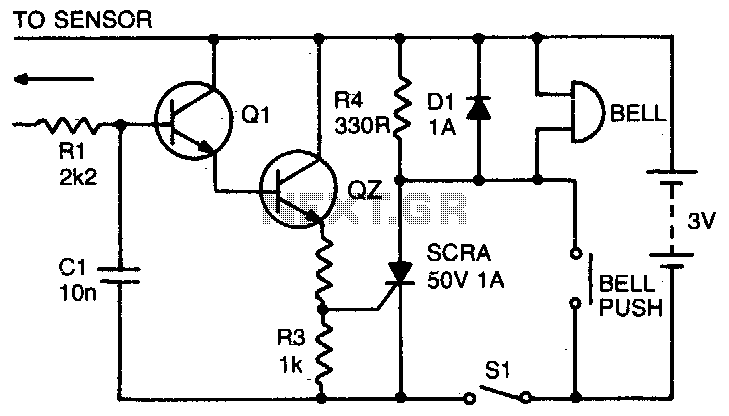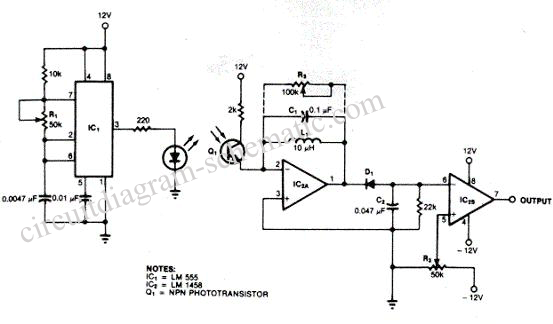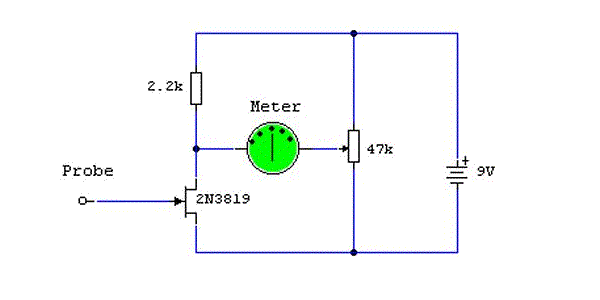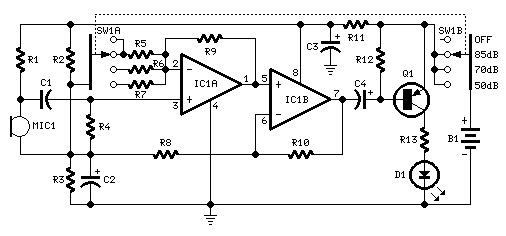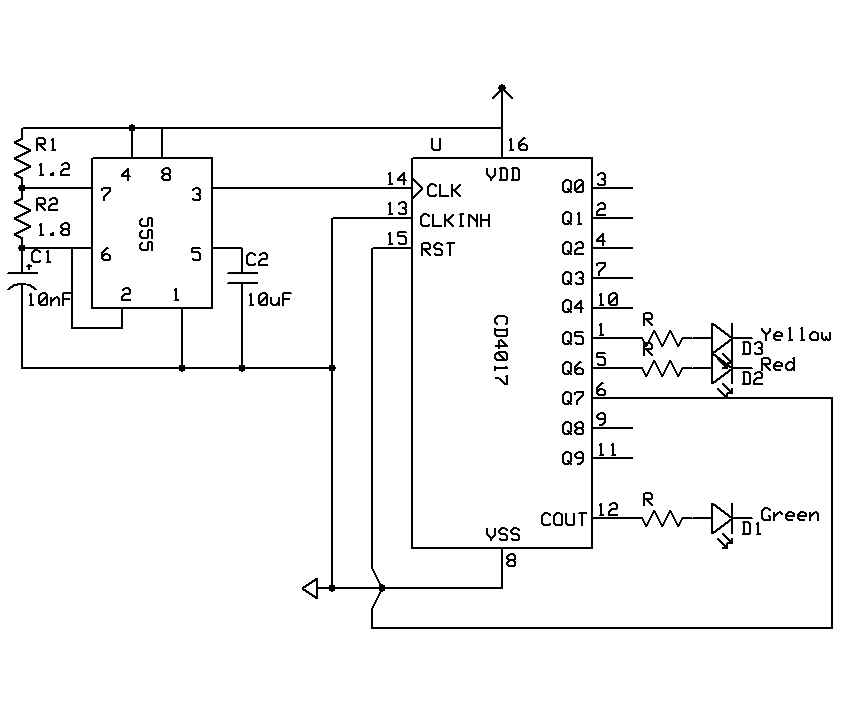
Rain Detectors

This rain detector alerts users immediately when it starts to rain, providing enough time to close windows and secure belongings. The battery-operated circuit consumes minimal current when the sensor is dry and maintains low current consumption when the buzzer is activated, allowing a pair of AA cells to last for an extended period. Alternatively, a molded power supply with a simple voltage regulator can be used to reduce the voltage to 3 volts. The circuit functions as a basic flasher circuit that operates effectively on only 3 volts using standard silicon transistors. When triggered, the buzzer emits a pulse approximately once per second for a brief duration, producing a sound reminiscent of dripping water. The beep duration can be extended by increasing the 1 µF capacitor. The 10 k resistor can also be adjusted for a longer beep time without affecting the beep rate, although there is a limit beyond which the circuit may malfunction, depending on the transistors' gain. Various transistors can be used, but when opting for older, low-gain transistors in metal packages, it may be advisable to substitute a 4.7 k resistor and a 2.2 µF capacitor for the 10 k resistor and 1 µF capacitor. The 1 µF capacitor can be of any type, with a 16-volt aluminum electrolytic being a common choice. Since the capacitor may experience about 0.5 volts of reverse bias, a tantalum capacitor rated at 10 volts or higher is preferable, as it can handle around 10% of its rating in reverse. A non-polar ceramic capacitor is also suitable, but a low-cost electrolytic can be utilized due to the large resistor in series, which limits reverse current. The switch can be any single-pole, single-throw type. The chosen switch, sourced from surplus, includes an unnecessary spring-loaded momentary position. It is wired to supply power to the circuit in both positions, enabling a "test" mode to check if the sensor has dried sufficiently to reactivate the circuit. AA alkaline batteries are used, with wires soldered directly to the terminals for connections. However, direct soldering to batteries should be performed quickly to avoid damage, and a battery holder is recommended for those less experienced with soldering. The construction and components are not critical, but a connector for the sensor is advisable for ease of maintenance. An ordinary 1/8" earphone-style connector was used in this design. The rain sensor can be constructed in various ways, typically consisting of two conductors bridged by rainwater. A simple sensor design involves two bare copper wires woven through staggered holes to keep the conductors close without contact. Standard phone cable connects to the electronics. An economical sensor can be made using a penny and a nickel separated by a plastic insulator, with raindrops bridging the gap to trigger the circuit. The unit is designed to be weatherproof and durable. To create the sensor, drill a small hole in the center of a penny for a copper-plated nail to pass through, soldering the nail's head to the penny to seal it against rain. A thin plastic sheet, slightly larger than the penny, can be sourced from items like drink bottle lids or packaging. Spray adhesive can be used to coat the plastic.
The rain detector circuit is designed to provide a reliable and practical solution for detecting rainfall. The core of the circuit consists of a sensor that detects the presence of water, which completes the circuit and triggers an audible alarm. The use of common components such as silicon transistors ensures that the circuit can be easily assembled and maintained.
The circuit operates at a low voltage of 3 volts, making it suitable for battery operation, which is advantageous for portability and ease of installation. The design allows for flexibility in component selection, particularly in the choice of transistors and capacitors, which can be adapted based on availability and desired performance characteristics.
The audible alarm is generated by a buzzer that emits a sound pattern simulating dripping water, effectively alerting users to the onset of rain. The design allows for adjustments to the beep duration and frequency, providing customization options to suit user preferences.
For optimal performance, care should be taken in the construction of the sensor to ensure reliable operation in outdoor conditions. The weatherproof design enhances the longevity of the device, making it a practical addition to any home or outdoor setting. Overall, the rain detector circuit is an effective solution for monitoring rainfall, providing timely alerts to prevent damage to property and belongings.This rain detector will give you a heads-up the instant it starts to rain, hopefully giving you time to close windows and bring in possessions. The battery-powered circuit draws virtually no current when the sensor is dry and the current consumption is low when the buzzer is activated so a couple of AA cells will last a long time.
Alternately, a m olded power supply with a simple voltage regulator to drop the voltage to 3 volts could be used. The circuit is basically a handy flasher circuit that operates well on only 3 volts using ordinary silicon transistors. When the circuit is triggered, the buzzer is pulsed about once per second for a very short time, giving it a "dripping water" sound which seems appropriate.
A slower, longer beep may be had by increasing the 1 uF capacitor. The 10 k resistor may be increased for a longer beep time without decreasing the beep rate but at some point the circuit will cease to function properly, depending on the gain of the transistors. Just about any transistors will work but if you choose to use older, low gain transistors in metal cans just because they are so good looking (like I did), it might be best to try a 4.
7 k and 2. 2 uF in place of the 10 k and 1 uF. (I had no trouble with a 2N2222 and 2N2906 with the values shown but those are modern types. ) The 1uF capacitor may be just about any type, with a 16 volt aluminum electrolytic being the most likely choice. The capacitor will see about 1/2 volt reverse bias at times so a 10 volt or higher tantalum capacitor is a better choice; they can handle about 10% of their rating in reverse.
A non-polar ceramic capacitor is also a good choice but don`t hesitate to use a cheap electrolytic since there is a large resistor in series limiting the reverse current and this isn`t exactly a deep space probe! The switch is any single-pole, single-throw type. My switch, grabbed from the surplus bin, has an unnecessary spring-loaded momentary position, too. I wired it to supply power to the circuit in both positions with the idea that the "test" position is for determining if the sensor has dried sufficiently to turn the circuit back on.
Just an excuse to use the switch! The batteries are just AA alkaline cells with wires directly soldered to the ends for connections. Directly soldering to a battery is a delicate process and I recommend a battery holder for the less experienced solderer. You must make the joint very quickly or the battery will be damaged! Don`t dwell on it! Neither the construction or the components are critical but I do recommend a connector for the sensor to make it easy to work on the box.
I used an ordinary 1/8" earphone style connector. The rain sensor may be built any number of ways and is simply two conductors that are bridged by the rain water. A simple sensor is shown below. Two conductors of bare copper wire are woven through the holes so that the conductors are near each other but do not come into contact.
Notice the holes each conductor uses are staggered so the loops underneath miss each other. Ordinary phone cable is used to connect to the electronics. This probe will cost at least 6 cents! It consists of a penny and nickel sandwiched together with a plastic insulator in the middle. Rain drops bridge the gap between the coins, triggering the circuit. The unit is quite weatherproof and should last for years. Here`s how to make it: First, drill a small hole in the center of a penny just big enough for a copper plated nail to pass through. Solder the head of the nail to the penny with a complete fillet to seal out the rain. Now find a fairly thin sheet of plastic slightly bigger than the penny. Possible sources include the lid from a drink bottle or a lid from a peanut jar. I used a flat section of plastic from a bubble packaged product. (My particular choice was quite thin and the sensor takes a long time to dry out. ) Coat the plastic with spray adhesive and pus 🔗 External reference
The rain detector circuit is designed to provide a reliable and practical solution for detecting rainfall. The core of the circuit consists of a sensor that detects the presence of water, which completes the circuit and triggers an audible alarm. The use of common components such as silicon transistors ensures that the circuit can be easily assembled and maintained.
The circuit operates at a low voltage of 3 volts, making it suitable for battery operation, which is advantageous for portability and ease of installation. The design allows for flexibility in component selection, particularly in the choice of transistors and capacitors, which can be adapted based on availability and desired performance characteristics.
The audible alarm is generated by a buzzer that emits a sound pattern simulating dripping water, effectively alerting users to the onset of rain. The design allows for adjustments to the beep duration and frequency, providing customization options to suit user preferences.
For optimal performance, care should be taken in the construction of the sensor to ensure reliable operation in outdoor conditions. The weatherproof design enhances the longevity of the device, making it a practical addition to any home or outdoor setting. Overall, the rain detector circuit is an effective solution for monitoring rainfall, providing timely alerts to prevent damage to property and belongings.This rain detector will give you a heads-up the instant it starts to rain, hopefully giving you time to close windows and bring in possessions. The battery-powered circuit draws virtually no current when the sensor is dry and the current consumption is low when the buzzer is activated so a couple of AA cells will last a long time.
Alternately, a m olded power supply with a simple voltage regulator to drop the voltage to 3 volts could be used. The circuit is basically a handy flasher circuit that operates well on only 3 volts using ordinary silicon transistors. When the circuit is triggered, the buzzer is pulsed about once per second for a very short time, giving it a "dripping water" sound which seems appropriate.
A slower, longer beep may be had by increasing the 1 uF capacitor. The 10 k resistor may be increased for a longer beep time without decreasing the beep rate but at some point the circuit will cease to function properly, depending on the gain of the transistors. Just about any transistors will work but if you choose to use older, low gain transistors in metal cans just because they are so good looking (like I did), it might be best to try a 4.
7 k and 2. 2 uF in place of the 10 k and 1 uF. (I had no trouble with a 2N2222 and 2N2906 with the values shown but those are modern types. ) The 1uF capacitor may be just about any type, with a 16 volt aluminum electrolytic being the most likely choice. The capacitor will see about 1/2 volt reverse bias at times so a 10 volt or higher tantalum capacitor is a better choice; they can handle about 10% of their rating in reverse.
A non-polar ceramic capacitor is also a good choice but don`t hesitate to use a cheap electrolytic since there is a large resistor in series limiting the reverse current and this isn`t exactly a deep space probe! The switch is any single-pole, single-throw type. My switch, grabbed from the surplus bin, has an unnecessary spring-loaded momentary position, too. I wired it to supply power to the circuit in both positions with the idea that the "test" position is for determining if the sensor has dried sufficiently to turn the circuit back on.
Just an excuse to use the switch! The batteries are just AA alkaline cells with wires directly soldered to the ends for connections. Directly soldering to a battery is a delicate process and I recommend a battery holder for the less experienced solderer. You must make the joint very quickly or the battery will be damaged! Don`t dwell on it! Neither the construction or the components are critical but I do recommend a connector for the sensor to make it easy to work on the box.
I used an ordinary 1/8" earphone style connector. The rain sensor may be built any number of ways and is simply two conductors that are bridged by the rain water. A simple sensor is shown below. Two conductors of bare copper wire are woven through the holes so that the conductors are near each other but do not come into contact.
Notice the holes each conductor uses are staggered so the loops underneath miss each other. Ordinary phone cable is used to connect to the electronics. This probe will cost at least 6 cents! It consists of a penny and nickel sandwiched together with a plastic insulator in the middle. Rain drops bridge the gap between the coins, triggering the circuit. The unit is quite weatherproof and should last for years. Here`s how to make it: First, drill a small hole in the center of a penny just big enough for a copper plated nail to pass through. Solder the head of the nail to the penny with a complete fillet to seal out the rain. Now find a fairly thin sheet of plastic slightly bigger than the penny. Possible sources include the lid from a drink bottle or a lid from a peanut jar. I used a flat section of plastic from a bubble packaged product. (My particular choice was quite thin and the sensor takes a long time to dry out. ) Coat the plastic with spray adhesive and pus 🔗 External reference
